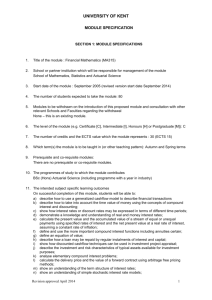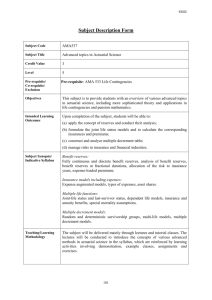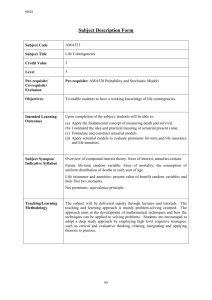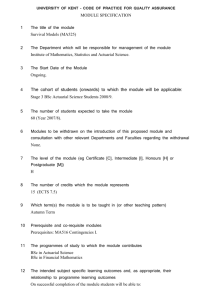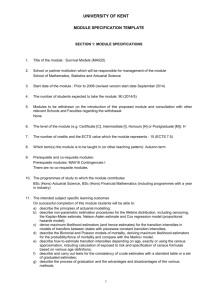Faculty of Commerce and Economics School of Actuarial Studies
advertisement
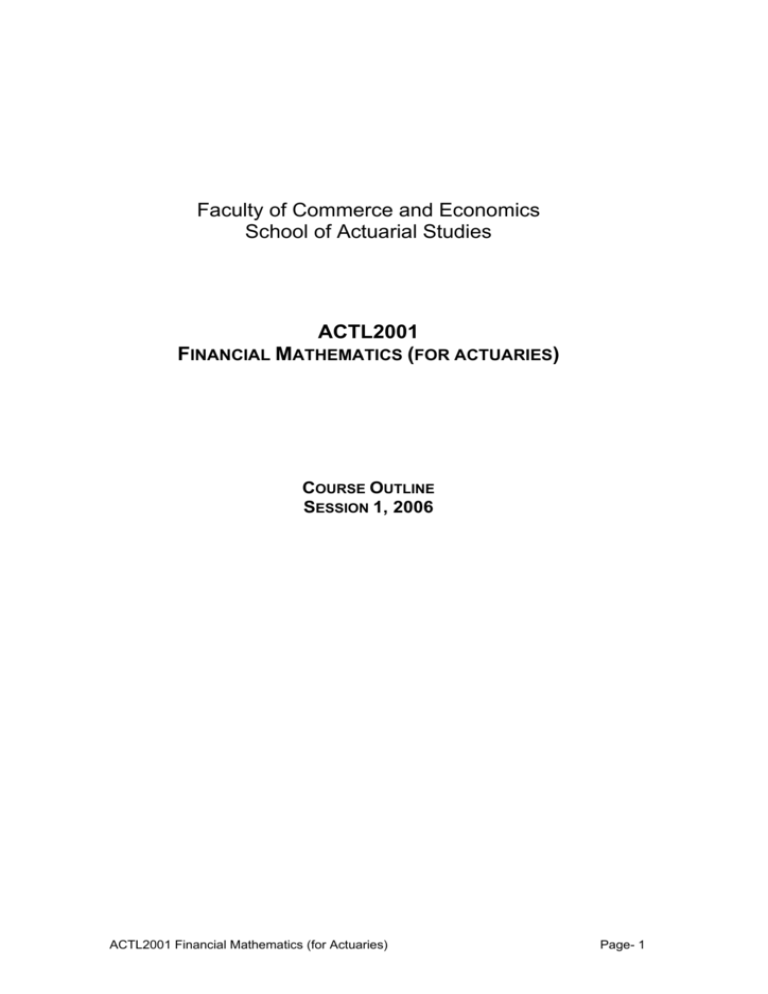
Faculty of Commerce and Economics School of Actuarial Studies ACTL2001 FINANCIAL MATHEMATICS (FOR ACTUARIES) COURSE OUTLINE SESSION 1, 2006 ACTL2001 Financial Mathematics (for Actuaries) Page- 1 Dear Students Welcome to ACTL2001 Financial Mathematics (for Actuaries). This course is one of eight courses for the BCom Actuarial major. Most of you will also be completing ACTL2002 Probability and Statistics for Actuaries in this session. If you are completing a combined BSc/BCom then you will be completing statistics/mathematics courses as part of the BSc in place of ACTL2002. In Session 2 you should all be completing ACTL2003 Stochastic Models for Actuarial Applications. Financial mathematics is a fundamental tool used by actuaries and actuarial graduates in the financial services industry. In the early days of the actuarial profession is was necessary to develop the mathematics of financial transactions, of annuities and of loans as well as models for mortality in life insurance products. This course will provide you with a foundation in the financial mathematics required for modern financial markets and provide a foundation for courses in your actuarial major in the final years of undergraduate study at UNSW. We hope you find the course challenging and interesting. This course outline has details of the course requirements, course aims and learning outcomes, content, teaching methods, assessment tasks, texts and readings, and expectations. Please read it carefully and thoroughly as it will be assumed that you are familiar with the contents. If you have any questions about the course at any time then please contact us. We look forward to guiding your learning through the duration of the course. Michael Sherris and Randell Heyman ACTL2001 Financial Mathematics (for Actuaries) Page- 2 1. COURSE STAFF 4 1.1 Communication with Staff 4 2. INFORMATION ABOUT THE COURSE 4 2.1 Teaching times and Locations 2.2 Units of Credit 2.3 Parallel teaching in the course 2.4 Relationship of this course to other course offerings 2.5 Approach to learning and teaching 4 5 5 5 5 3. COURSE AIMS AND OUTCOMES 6 3.1 Course Aims 3.2 Student Learning Outcomes 3.3 Teaching Strategies 6 7 7 4. STUDENT RESPONSIBILITIES AND CONDUCT 7 4.1 Workload 4.2 Attendance 4.3 General Conduct and Behaviour 4.4 Keeping informed 7 7 8 8 5. LEARNING ASSESSMENT 8 5.2 Assessment Details 5.3 Assignment Submission Procedure 5.4 Late Submission 5.5 Special Consideration and Supplementary examinations 5.6 Assignment Format 8 9 9 10 11 6. ACADEMIC HONESTY AND PLAGIARISM 11 7. STUDENT RESOURCES 12 7.1 Course Resources 7.2 Other Resources, Support and Information 12 12 8. CONTINUAL COURSE IMPROVEMENT 13 9. COURSE SCHEDULE 14 ACTL2001 Financial Mathematics (for Actuaries) Page- 3 1. COURSE STAFF The Course Coordinator of this course is: Staff E-mail Rm Telephone Prof Michael Sherris m.sherris@unsw.edu.au JG G31 9385 2333 He is responsible for the administration and final assessment of the course. The Course Lecturer of this course is Staff E-mail Rm Randell Heyman randell@unsw.edu.au JG G35 He is responsible for the lectures and related teaching and learning. Telephone 9385 3360 Tutors for this course are Staff E-mail Rm Telephone Shaun Yow shaun.yow@student.unsw.edu.au JG 239 9385 8005 JG 239 9385 8005 Tony Siu actl2001@gmail.com They are responsible for the tutorials and grading of quizzes and assignment assessment tasks. 1.1 Communication with Staff Professor Sherris will normally be available for consultation on Mondays during teaching session from 4pm to 6pm and Tuesday from 3pm to 4pm in JG G31. Appointments should normally be made in advance using email. Randell Heyman will normally be available for consultation on Mondays during teaching session from 2pm to 3pm and Tuesdays from 3pm to 4pm in JG G35. Appointments should normally be made in advance using email. Tutors are available for consultation in JG 239. Times will be posted on the web site. If students have questions about the material covered in lectures then consult the Course Lecturer Randell Heyman. For tutorial problems or other problems with assignments and course material students should consult the tutors. For administrative matters related to the course including enrolment, tutorial enrolment, assessment, special consideration, and the course web site, students should consult the Course Coordinator or the School Administrator. 2. INFORMATION ABOUT THE COURSE 2.1 Teaching times and Locations Lectures This Course consists of a 2 hour lecture and a 1 hour tutorial. The lecture is held on Tuesdays 1:00pm – 3:00pm BIOMED Theatre A Timetables and locations are correct at time of printing. A full timetable of lectures and topics is provided later in this Course study guide. Any alterations to the lecture times or locations will be advised in lectures and via the Course WebCT Vista site. Students should consult the WebCT Vista site on a regular basis, since assignment questions and other Course materials will be placed there. ACTL2001 Financial Mathematics (for Actuaries) Page- 4 Tutorials Scheduled Tutorial Session Times are as follows: T1 T2 T3 T4 T5 Tue Thu Thu Thu Thu 10:00 am – 11:00 am 13:00 pm – 14:00 pm 14:00 pm – 15:00 pm 14:00 pm – 15:00 pm 15:00 pm – 16:00 pm CE 713 QUAD G026 QUAD G026 ME 304 ME 304 Students must attend the tutorial for which they are enrolled. Attendance will be recorded and count towards meeting the requirements to pass the course. The lecture and tutorial times are correct at time of printing. Students are reminded that they should check the Course WebCT Vista site for any amendments. 2.2 Units of Credit 6 2.3 Parallel teaching in the course Students enrolled in ACTL2001 must attend the undergraduate lectures. Students attending ACTL5102 must be enrolled in the Master of Actuarial Studies. Faculty and School policy does not allow undergraduate attendance at postgraduate lectures. 2.4 Relationship of this course to other course offerings This course is coverage of financial mathematics at an introductory level with a strong foundation in mathematics. The assumed knowledge of the course is a good understanding of mathematics as covered in MATH1151 and MATH1152. Students with equivalent mathematics coverage at a very high grade in MATH1131 or MATH1141 or ECON1202 may also have the required mathematical background. Consult the Course Coordinator if you do not have the required mathematical background. ACTL2001 Financial Mathematics builds on the basic concepts of financial mathematics covered in ACTL1001 Actuarial Studies and Commerce. Parts of the course will apply some of the concepts covered in ACTL2002 Probability and Statistics for Actuaries. More advanced models are covered in ACTL2003 Stochastic Models for Actuarial Applications. The course is necessary knowledge for the more advanced coverage in ACTL3004 Financial Economics for Insurance and Superannuation and an introduction to the more extensive coverage in ACTL3002 Life Insurance and Superannuation Models. Students should have a solid background in mathematics and are assumed to be able to use a computer to analyse financial problems. You should be able to use a word processing package (such as WORD) and a spreadsheet (such as EXCEL). Students should use whatever computer programs they are most familiar with in doing assignments and other assigned tasks. 2.5 Approach to learning and teaching The course textbooks, lectures and assessment tasks are designed to provide a framework for your learning. Every student has a different approach to learning. How much time you spend on reading in preparation for lectures, completing assessment tasks, reviewing course objectives, deepening your understanding and preparing for final examinations will depend on your learning approach. Lectures will generally cover the main concepts and issues and will not necessarily cover all the details of the ACTL2001 Financial Mathematics (for Actuaries) Page- 5 course readings or texts. It is expected that you have read the reading material for the lecture in advance. Students who are successful in this course take an active approach to learning. 3. COURSE AIMS AND OUTCOMES 3.1 Course Aims Course Description This Course develops the financial mathematics required for the analysis of financial and insurance transactions. Topics covered include: mathematics of compound interest; valuation of cash flows of simple insurance contracts; analysis and valuation of annuities, bonds, loans and other securities; yield curves and immunisation; introduction to stochastic interest rate models and actuarial applications. Course Aims The aims of this course are to provide students with an understanding of: • The main features of financial instruments including bonds, loans, forward contracts, options and life insurance contracts. • Market conventions used in quoting and pricing securities in Australia and how these can differ between countries and financial instruments. • The underlying concepts and techniques used to value fixed and known cash flows on financial instruments including bonds and loans • The underlying concepts and techniques used to value cash flows contingent on values of cash flows such as forward and option contracts. • The underlying concepts and techniques used to value cash flows contingent on survival and death such as life insurance policies and annuities. Course Aims of the Institute of Actuaries CT1 Financial Mathematics syllabus (including introduction to CT 5 Contingencies) 1. Describe how to use a generalised model to describe financial transactions, making allowance for the probability of payment. 2. Describe how to take into account the time value of money using the concepts of compound interest and discounting. 3. Show how interest rates or discount rates may be expressed in terms of different time periods. 4. Demonstrate a knowledge and understanding of real and money interest rates. 5. Calculate the present value and the accumulated value of a stream of equal or unequal payments using specified rates of interest and the net present value at a real rate of interest, assuming a constant rate of inflation. 6. Define and use the more important compound interest functions including annuities certain. 7. Define an equation of value. 8. Describe how a loan may be repaid by regular instalments of interest and capital. 9. Show how discounted cashflow techniques can be used in investment project appraisal. 10. Describe the investment and risk characteristics of bonds, shares and derivatives 11. Analyse elementary compound interest problems. 12. Calculate the delivery price and the value of a forward contract using arbitrage free pricing methods. 13. Show an understanding of the term structure of interest rates. ACTL2001 Financial Mathematics (for Actuaries) Page- 6 14. Define simple insurance and annuity contracts, and develop formulae for the means and variances of the present values of the payments under these contracts, assuming constant deterministic interest. 15. Compute expected present values and variances of simple insurance/annuity benefits by table look up or by using life tables. 3.2 Student Learning Outcomes At the end of this course students should have: 1. Developed an understanding of the basic techniques used to value cash flows on securities including bonds, loans, forward contracts, options and life insurance contracts 2. Developed an ability to assess risk in fixed interest cash flows. 3. Developed an understanding of basic market conventions in security markets. 4. Enhanced their skills of integrating financial valuation concepts and their application to practical situations. 5. Developed the ability to assess financial calculations for reasonableness. 6. Developed an ability to apply technical skills to practical valuation problems in financial markets. 7. Developed basic presentation and discussion skills for explaining financial mathematics problems in simple terms. 3.3 Teaching Strategies Lectures will cover the main topics and provide coverage of the course concepts. They are an opportunity for students to develop an understanding of the main topics covered in the course and the level of knowledge expected. They provide a guide to the course of study during the session and what material students need to read and review. Students will need to read the prescribed readings prior to the lecture. Tutorials are for students to ask questions on aspects of the course that need further clarification, to develop presentation skills, and to interact with other students in the course. Students need to attempt the tutorial problems prior to the tutorial and identify problems that require further discussion. They are an opportunity to learn from other students and to develop team skills by working on problems with other students. 4. STUDENT RESPONSIBILITIES AND CONDUCT 4.1 Workload It is expected that you will spend at least ten hours per week studying this course. This time should be made up of reading, working on tutorial exercises and additional problems, and attending classes. In periods where you need to complete assignments or prepare for examinations, the workload may be greater. Over-commitment has been a cause of failure for many students. You should take the required workload into account when planning how to balance study with employment and other activities. 4.2 Attendance Your regular and punctual attendance at lectures and seminars is expected in this course. University regulations indicate that if students attend less than eighty per cent of scheduled classes they may be refused final assessment. ACTL2001 Financial Mathematics (for Actuaries) Page- 7 4.3 General Conduct and Behaviour You are expected to conduct yourself with consideration and respect for the needs of your fellow students and teaching staff. Conduct which unduly disrupts or interferes with a class, such as ringing or talking on mobile phones, is not acceptable and students may be asked to leave the class. More information on student conduct is available at: www.my.unsw.edu.au 4.4 Keeping informed You should take note of all announcements made in lectures, tutorials or on the course web site. From time to time, the University will send important announcements to your university e-mail address without providing you with a paper copy. You will be deemed to have received this information. 5. LEARNING ASSESSMENT 5.1 Formal Requirements In order to pass the course students must complete and submit all components of assessment on or before the due date. Late assessment submissions will not be marked. It is important that students be punctual and reliable when submitting assessment. This is an important workplace requirement and students need to ensure they meet deadlines. The following table gives the relative weighting of the assessment components: Tutorial Presentation Class Quizzes Major Assignment Final Examination Total 5% 15% 10% 70% 100% In order to pass the course student must perform satisfactorily in all course assessment components. 5.2 Assessment Details Tutorial Presentation Communication skills is one of the most important graduate attributes that employers of commerce and actuarial graduates require. Students need to be able to explain complex financial concepts and problems in simple terms and to be able to explain why their answer is reasonable. Tutorial presentations provide an opportunity for you to develop this skill. During the session, students will be allocated a tutorial presentation. Each tutorial presentation consists of an oral presentation and discussion of at least one of the tutorial exercises set for that week. Written answers to the tutorial exercises presented must be handed in at the end of the tutorial. Failure to appear on time for an oral presentation, or to submit a written answer, will result in a zero mark and unsatisfactory performance for the purposes of passing the course unless a satisfactory reason is given in writing to the Course Coordinator. ACTL2001 Financial Mathematics (for Actuaries) Page- 8 Marks will be assigned based on the presentation assessment criteria that are provided on the course web site. Students should review this before their presentation. Class Tests Technical skills are important in practice and this course provides foundation technical skills that will be useful throughout your working life. In order to assess your understanding of the technical skills covered in the course aims there will be two 45-minute class quizzes during the session. The quizzes will be administered during lectures. Each quiz will be worth 7.5% of the total assessment for the course. The quizzes will be closed book. Students will only be allowed to bring the text "Formulae and Tables for Actuarial Examinations" into the quizzes. Normal examination rules apply to the conduct of class quizzes. Calculators will be allowed in the class quizzes and the final examination but a clear indication of all of the steps involved in your calculations must be shown. The university will not supply calculators to students for use in examinations where the provision of calculators has not been requested by the course examiner. It is the student’s responsibility to be familiar with the rules governing the conduct of examinations. Assignments The practical application of the course concepts based on actual financial market problems is an important graduate attribute that employers require and this course aims to provide at least some introductory exposure to this. Writing skills for technical material are also important. There will be one major Assignment for this course involving the practical application of course concepts to a financial market problem. This will provide students with an opportunity to also develop writing skills. The assignments you submit must be your own work. The assignments will be assessed on both technical accuracy, practical application and how well it is written and the quality of the assignment presentation. Final Examination The final examination will assess students understanding of the concepts covered in the course and their ability to apply them to financial market problems. The final examination will be a three-hour written paper. The final examination will be closed book. Students will only be allowed to bring the text "Formulae and Tables for Actuarial Examinations" into the exam. 5.3 Assignment Submission Procedure Assignments must be placed in the box provided under the Actuarial Studies notice board near the Actuarial Studies Administrators Office (Rm G31, John Goodsell Building). A cover sheet must accompany these assignments. A copy of the cover sheet is available from the course web site. Additional copies of the cover sheet can be obtained from the Actuarial Studies Web Page or at the Actuarial Studies Administrators Office (Rm G31, John Goodsell Building). Please note that it is School policy that late assignments will not be marked. 5.4 Late Submission The School of Actuarial Studies has a policy of grading late assignments with a zero mark. Punctual submission of work is required in order to satisfy the requirements of ACTL2001 Financial Mathematics (for Actuaries) Page- 9 the course. The assignment may be marked at the discretion of the course coordinator if there is a valid reason for late submission and used in cases where your final overall results are marginal. 5.5 Special Consideration and Supplementary examinations UNSW policy and process for Special Consideration applies (see https://my.unsw.edu.au/student/atoz/SpecialConsideration.html). Specifically: • Applications for special consideration (including supplementary examinations) must go through UNSW Central administration (within 3 working days of the assessment to which it refers) – applications will not be accepted by teaching staff; • Applying for special consideration does not automatically mean that you will be granted additional assessment or that you will be awarded an amended result; • If you are making an application for special consideration (through UNSW Central Administration) please notify your Course Coordinator or Lecturer in Charge; • Please note: a register of applications for Special Consideration is maintained. History of previous applications for Special Consideration is taken into account when considering each case. Supplementary Examination and Special Consideration Students who believe that their performance in this course, either during session or in an examination, has been adversely affected by sickness, misadventure or other circumstances beyond their control may apply for special consideration for affected assessments. See the University web site for more details: http://www.student.unsw.edu.au/atoz/atoz-Special.shtml Students may be required to sit for an oral or written supplementary examination. Any supplementary examination date will be advised to students after the final examination. In general, a supplementary examination will only be offered to a student who has been prevented from taking the Final Examination who has been placed at a serious disadvantage during the examination, and whose circumstances have improved considerably in the period since the relevant examination was held. Failure to attend a supplementary examination, if you have been granted one, will result in forfeiture of any additional assessment granted to you. Satisfactory performance in any course assessment is required in order to be granted a supplementary examination. STUDENTS SHOULD NOTE THAT SPECIAL CONSIDERATION WILL NOT BE GRANTED UNLESS PERFORMANCE AND ATTENDANCE AT LECTURES IS SATISFACTORY. THIS WILL USUALLY MEAN THAT YOU WILL HAVE TO PASS ALL ASSESMENT TASKS IN ORDER FOR ANY SPECIAL CONSIDERATION TO BE GIVEN. Consideration for Missed Assessments (other than final examination) If you miss a test or are unable to submit your assignment by the due time & date, and you have a valid reason, you need to inform the Actuarial Studies office as soon as possible. You must provide written documentation requesting consideration to the Actuarial Studies office, in the form of a letter explaining your reasons with evidence attached, i.e. medical certificate, police report etc. You should note the course details, your student ID and contact details in your letter as well. As per University rules these considerations must be submitted within 3 working days of the assessment date. If no request is received or it is received after 3 working days you will be awarded a zero mark for that assessment. ACTL2001 Financial Mathematics (for Actuaries) Page- 10 Review of Results of Assessments (other than final examination) As per University rules, if you wish a piece of course assessment to be re-checked, for addition error or incorrect marking, you need to contact the Actuarial Studies office within 15 working days of the assessment being available for collection. You will need to bring in the assessment and provide a note as to the error or reason for review to the Actuarial Studies office. The assessment will be passed onto the relevant academic for review. Students will be able to collect back the assessment from the Actuarial Studies office. Equity and diversity Those students who have a disability that requires some adjustment in their teaching or learning environment are encouraged to discuss their study needs with the course coordinator prior to, or at the commencement of, their course, or with the Equity Officer (Disability) in the Equity and Diversity Unit (9385 4734 or www.equity.unsw.edu.au/disabil.html). Issues to be discussed may include access to materials, signers or note-takers, the provision of services and additional exam and assessment arrangements. Early notification is essential to enable any necessary adjustments to be made. 5.6 Assignment Format Details of format for submission of assignments are included with the assignment and available from the course web site. 6. ACADEMIC HONESTY AND PLAGIARISM The University regards plagiarism as a form of academic misconduct, and has very [m2]strict rules regarding plagiarism. For full information regarding policies, penalties and information to help you avoid plagiarism see: http://www.lc.unsw.edu.au/plagiarism/index.html Plagiarism is the presentation of the thoughts or work of another as one’s own.* Examples include: • direct duplication of the thoughts or work of another, including by copying work, or knowingly permitting it to be copied. This includes copying material, ideas or concepts from a book, article, report or other written document (whether published or unpublished), composition, artwork, design, drawing, circuitry, computer program or software, web site, Internet, other electronic resource, or another person’s assignment without appropriate acknowledgement; • paraphrasing another person’s work with very minor changes keeping the meaning, form and/or progression of ideas of the original; • piecing together sections of the work of others into a new whole; • presenting an assessment item as independent work when it has been produced in whole or part in collusion with other people, for example, another student or a tutor; and, • claiming credit for a proportion a work contributed to a group assessment item that is greater than that actually contributed.† Submitting an assessment item that has already been submitted for academic credit elsewhere may also be considered plagiarism. The inclusion of the thoughts or work of another with attribution appropriate to the academic discipline does not amount to plagiarism. Students are reminded of their Rights and Responsibilities in respect of plagiarism, as set out in the University Undergraduate and Postgraduate Handbooks, and are encouraged to ACTL2001 Financial Mathematics (for Actuaries) Page- 11 seek advice from academic staff whenever necessary to ensure they avoid plagiarism in all its forms. The Learning Centre website is the central University online resource for staff and student information on plagiarism and academic honesty. It can be located at: www.lc.unsw.edu.au/plagiarism The Learning Centre also provides substantial educational written materials, workshops, and tutorials to aid students, for example, in: • • • correct referencing practices; paraphrasing, summarising, essay writing, and time management; appropriate use of, and attribution for, a range of materials including text, images, formulae and concepts. Individual assistance is available on request from The Learning Centre. Students are also reminded that careful time management is an important part of study and one of the identified causes of plagiarism is poor time management. Students should allow sufficient time for research, drafting, and the proper referencing of sources in preparing all assessment items. * Based on that proposed to the University of Newcastle by the St James Ethics Centre. Used with kind permission from the University of Newcastle † Adapted with kind permission from the University of Melbourne. 7. STUDENT RESOURCES 7.1 Course Resources Textbooks The textbooks for the course are: Broverman, S.A. (2004), Mathematics of Investment and Credit, 3nd Edition, ACTEX Publications. [A solutions manual is available for purchase.] Sherris, M. (1996), Money and Capital Markets, Pricing, Yields and Analysis, 2nd Edition, Allen & Unwin. Other References The following references provide a detailed and comprehensive coverage of the topics covered in the Course. This Course is an introductory Course, so many of these references are mainly appropriate for further study and research. The Actuarial Education Company, Course CT1 Study Guide. McCutcheon, J.J., and Scott, W.F. (1986), An Introduction to the Mathematics of Finance, William Heineman. [out of print] Benninga, S. (2000), Financial Modeling, The MIT Press, 2nd Edition. Luenberger, D.G. (1998), Investment Science, Oxford University Press. Panjer, H.H., ed. (1997), Financial Economics with Investment, Insurance and Pension Applications, Society of Actuaries. Gerber, H.U. (1997), Life Insurance Mathematics, Springer-Verlag, 3rd Edition. Bowers, N.L. Gerber, H.U., Hickman, J.C., Jones, D.A. and Nesbitt, C.J. (1997), Actuarial Mathematics, Society of Actuaries, 2nd Edition 7.2 Other Resources, Support and Information ACTL2001 Financial Mathematics (for Actuaries) Page- 12 The University and the Faculty provide a wide range of support services for students, including: Learning and study support FCE Education Development Unit (http://education.fce.unsw.edu.au ) UNSW Learning Centre (http://www.lc.unsw.edu.au ) EdTec – WebCT information (http://www.edtec.unsw.edu.au ) Counselling support - http://www.counselling.unsw.edu.au Library training and support services - http://info.library.unsw.edu.au Disability Support Services – Those students who have a some adjustment in their teaching or learning environment are their study needs with the Course Coordinator or (http://www.equity.unsw.edu.au/disabil.html). Early notification any necessary adjustments to be made. disability that requires encouraged to discuss the Equity Officer is essential to enable In addition, it is important that all students are familiar with University policies and procedures in relation to such issues as: Examination procedures and advice concerning illness or misadventure https://my.unsw.edu.au/student/academiclife/assessment/examinations/examinationrul es.html Occupational Health and Safety policies and student responsibilities; http://www.riskman.unsw.edu.au/ohs/Policies%20&%20Procedures/UNSW%20OHS% 20Accountability.pdf 8. CONTINUAL COURSE IMPROVEMENT Each course in actuarial studies at UNSW is reviewed each session by the course coordinator using student evaluative feedback from UNSW's Course and Teaching Evaluation and Improvement (CATEI) Process. Student feedback is taken seriously, and continual improvements are made to the course based on such feedback. Significant changes to the course are communicated to students taking the course. Your input into improving future offerings of the course is highly valued. As a result of the previous evaluation of the course planned improvements for this offering were to review the functioning of tutorials and to improve the feedback given to students for assessment tasks. For tutorials it was considered necessary to ensure time limits on student presentations were strictly adhered to so that there was sufficient time for discussion of more difficult problems in the tutorial. Tutors will also be required to provide students with more feedback on assessment tasks. ACTL2001 Financial Mathematics (for Actuaries) Page- 13 9. COURSE SCHEDULE Week 1 Lecture Tuesday 28 February 2006 1-3pm Bio A 2 Tuesday 7 March 2006 1-3pm Bio A Tuesday 14 March 2006 1-3pm Bio A 3 4 5 6 7 8 9 Tuesday 21 March 2006 1-3pm Bio A Tuesday 28 March 2006 1-3pm Bio A Topic Covered • Course overview • Cash flow modelling • Time value of money • Accumulating funds with simple/compound interest • Effective rates of interest • Present value and equations of value • Nominal interest rates • Rates of discount • Force of interest • Inflation and real interest rates • Annuities • Accumulated value and present value of an annuity • Deferred annuities • Annuities with payment period differing from interest conversion period • Continuous annuities • Annuities with non-constant payments • Yield rates and reinvestment rates CLASS QUIZZ 1 • Introduction to Spreadsheet Modelling • Loan Schedules • Interest and capital components of annuity payments • Taxation • Price and yield of fixed interest securities • Allowance for Inflation • Application to Equities • Project Appraisal Techniques Tuesday 4 April 2006 1-3pm Bio A Tuesday • 11 April 2006 • 1-3pm • Bio A Term structure of interest rates Duration and convexity Interest Rate Risk Management • UNIVERSITY RECESS Tuesday ANZAC DAY PUBLIC HOLIDAY 25 April 2006 No class Tuesday 2 May 2006 1-3pm Bio A • • • • Spot and forward rates Forward contracts, hedging and arbitrage Valuing forward contracts Futures Contracts ACTL2001 Financial Mathematics (for Actuaries) Page- 14 10 11 12 13 14 • • • • • Tuesday • 16 May 2006 • 1-3pm Bio A • Tuesday • 23 May 2006 • 1-3pm • Bio A • • Tuesday • 30 May 2006 • 1-3pm • Bio A • • • • Tuesday • 6 June 2006 • 1-3pm • Bio A • Tuesday 9 May 2006 1-3pm Bio A Swaps Options Arbitrage and Hedging Binomial Stock Option Pricing Assignment Submission Date Stochastic vs. deterministic modelling Independent and identically distributed interest rates: distributions of accumulated values Annuity accumulations Lognormal distribution of (l + i) Simulation Binomial lattices Arithmetic and geometric random walk CLASS QUIZZ 2 Random age-at-death Random time-until-death Survival probabilities Individual life insurance Insurance payable at the moment of death Insurance payable at the end of the year of death Present value of insurance benefits Discrete life annuities Continuous life annuities Relationships between annuities and insurances Present value of life annuities Exam Period *This timetable may be altered. Students will be advised of any changes in lectures and via the course web site. ACTL2001 Financial Mathematics (for Actuaries) Page- 15

